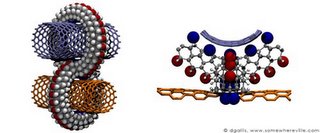Nanotechnology Introduction

Nanotechnology will become the key materials technology underlying all major developments during the 21st century. Already it is seeding breakthroughs in fields ranging from medicine to transportation to computing, and its impact will only accelerate in the coming decades.
Eric Drexler, the father of nanotechnology, layed out its initial conception in his 1986 seminal book, Engines of Creation. Drexler is also the founder of the Foresight Nanotech Institute, an organization dedicated to the safe and beneficial implementation of nanotechnology.
The term nanotechnology refers to a broad spectrum of technologies that utilize the ability to manipulate matter on a molecular or atomic level. From the forming of stone tools to the development of computers, humans have always been restricted to moving atoms and molecules in large herds. Even the development of silicon chips on the micrometer scale involves manipulating massive clusters of atoms. Nanotechnology transcends this limitation by giving precise control over every atom or molecule.
The implications for this kind of control are tremendous. Virtually anything could be constructed from cheap and abundant raw materials. Feed a nanoassembler sand and out comes a computer, feed it dirt and water and out comes any type of fruit or vegetable. Furthermore, these molecularly assembled products will be far superior to anything that can be constructed today. Nanotechnology will be able to construct materials and products that are many times lighter, stronger, smarter, and cleaner. The material cost of any product will shrink to pennies per pound and its value will be determined solely by the information of its design.
Already we have seen the development of carbon nanotubes, which are cylindrical arrays of carbon atoms 1/100,000 times the thickness of a human hair. Nanotubes are an extremely durable substance that possess hundreds of times the strength of steel with only a fraction of its weight. Nanotubes also exhibit both metallic and semiconducting properties making them excellent candidates to replace the much larger and less efficient transistors of today's microelectronics. Nanotube based electronics would produce computing devices billions of times faster and consume many times less energy.
However, these kinds of materials represent only the tip of the iceberg that nanotechnology will become. At the heart of nanotechnology exists the molecular level machine, or nanobot. Nanobots the size of cells will able to self-replicate, communicate with each other, and work together towards achieving any desired objective.
Nanobots injected into the blood stream would be able to continually clean and repair the body. They could kill pathogens, toxins, and cancer cells, repair DNA errors, and even take over biological functions and systems. This would not only provide radical life extension, it would also would make the body stronger, healthier, and more resilient than biologically possible.
These benefits are not limited to the body, they can also provide amazing potential for the brain. Nanobots injected into the blood vessels of the brain will be able to interact with our neurons to radically extend our biological intelligence and memory. In time we will be able to completely replace the slow biological hardware of the mind with far superior nanomachinery.
Nanobots can also be utilized to reverse the effects of pollution, such as by breaking down the damaging levels of carbon dioxide in the air. Furthermore, we wont have to rely on the burning of fossil fuels as our primary energy source. Nano based fuel cells will provide a clean, safe, and inexpensive renewable source of energy.
The potential benefits of nanotechnology during the 21st century are unfathomable. From eliminating disease and death, to ending poverty and pollution, to providing unlimited resources and energy, nanotechnology will become indispensable to humanity.
Unfortunately the potential dangers of such a powerful technology are equally as great. A few misguided individuals with the ability to manipulate matter on the atomic level could cause massive harm. Many cite the "grey goo" scenario as a potential risk, where out of control self replicating nanomachines rapidly consume large portions of the biosphere. However a much greater chance of risk comes from the ability to rapidly and inexpensively manufacture large quantities of highly advanced nano-weaponry.
Humans at their currently limited state of intelligence are likely unable to handle this kind of power. The best way to safeguard the planet would be the development of a smarter-than-human level of intelligence. Only then would we have the level of understanding necessary to insure our survival.



0 Comments:
Post a Comment
<< Home